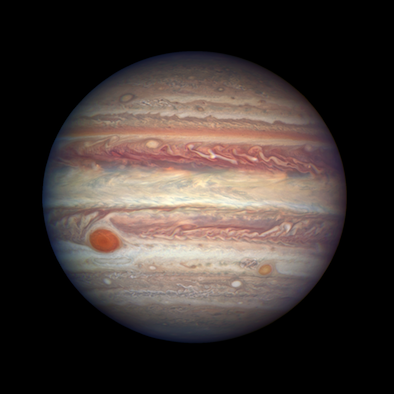GAM 2017 Blog
- Published: Friday, April 14 2017 00:00
By Samir Dhurde
Jupiter is a fascinating planet, being the envy of all others in its size. In fact it is also called a failed star - a gas giant that just missed the nuclear fusion bus, or else we on Earth could have had a Tatooine-like sunset scene sometimes. It is most of the time the 4th brightest object in our skies, only switching places for some time with Mars when the latter is at its closest to the Earth. Having been observed for millennia, it features in many human mythologies and cultural notes under so many names like Jove (Roman), Zeus (Greek), Bṛhaspati (Hindu), Al-Mushtari (Arabic), Mùxīng (Chinese), Mokusei (Japanese), Pirua (Incan) etc.
Opposition
It's a special Global Astronomy Month this year because on 8th April, 2017 the Earth was between the planet Jupiter and the Sun, placing Jupiter at "Opposition" to the Sun in our sky. One would see Jupiter rising above the horizon exactly at Sunset and would be able to see it throughout the night! Being at its closest position to the Earth during this period, Jupiter graces us with its brightest and undivided presence in the evening sky all this month and in the months ahead. So, let us note down a few ways to enjoy and make use of this opportunity.
 A dazzling capture of the face of Jupiter on this Opposition by the Hubble Space Telescope. (Credits: NASA, ESA, and A. Simon (NASA Goddard), Source: https://www.nasa.gov/feature/goddard/2017/hubble-takes-close-up-portrait-of-jupiter)
A dazzling capture of the face of Jupiter on this Opposition by the Hubble Space Telescope. (Credits: NASA, ESA, and A. Simon (NASA Goddard), Source: https://www.nasa.gov/feature/goddard/2017/hubble-takes-close-up-portrait-of-jupiter)
Peeking at Jove
One idea is of course to enjoy the view of the disc of the huge planet. For this you will need to have a small telescope at your disposal, at least similar to or bigger than what Galileo Galilee had used to take his paradigm-changing peeks at the "King of the Planets". When you look through your eyepiece, Jupiter’s profile will not look exactly circular. Jupiter is a gaseous planet and its equator bulges out due to its very fast rotation. The same also causes small, 10-hour days on this vast planet!
The face of Jupiter is quite dynamic because of this. There are two (or more if you are using a 6-inch or bigger telescope) brownish bands that you may catch on its cream-coloured disc. These darker cloud "belts" of Jupiter that appear between the lighter cloud "zones" are easy to spot. If you want a more challenging object, look for the famous Great Red Spot (GRS). This feature - a storm that is twice the size of the Earth, is quite elusive due to the fast rotation of the planet. With small telescopes, it could be difficult to identify unless it is right in the centre of the disc. Other than being small compared to the disc, it can become very pale and indistinguishable when it is at either of the edges.
The other enjoyable activities, while pointing your telescope to Jupiter, include observing the harmonious motions of the Moons of Jupiter. These firefly-like companions have been fascinating astronomers since Galileo discovered four of them — Io, Europa, Ganymede, and Callisto in 1610. Did you know that if it were not for their closeness to the bright Jupiter, all the "Galilean satellites" would be visible to the naked eye? Their visual magnitudes at opposition are - Io - 4.8, Europe - 5.2, Ganymede - 4.5 and Callisto - 5.5 , thus placing them well within the naked eye limit of around 6!
 Jupiter and its Moons through a 10-inch telescope. (Credit: Jan Sandberg, Source: https://commons.wikimedia.org/wiki/File:Jupiter-moons.jpg)
Jupiter and its Moons through a 10-inch telescope. (Credit: Jan Sandberg, Source: https://commons.wikimedia.org/wiki/File:Jupiter-moons.jpg)
|
It is quite easy to follow the positions of these Moons everyday with good binoculars or small telescopes (Galileo did it with a 2-incher!). Making a time-chart of their positions around the centre of Jupiter is a good project idea for those willing to spend some time everyday looking up. You will also be able to thus find out the time-periods of their revolutions around their gravitational commander. Obviously you will also sometimes catch these hovering in front of or disappearing behind Jupiter. Imagine how exciting it would be to be able to predict these transits and eclipses from your self-made time-chart. So start now! If planned early, you could also witness the rarer events where the moons occult or eclipse each other. All these make Jupiter a favourite for observers with small telescopes. Now that you know about them, this month is a great time to see & share these sights with everyone around you. In the continuation of this article, we will see suggestions for a very special project. |
|
Resources:
Of course sometimes you may have some urgent plans and may want quick predictions. There are several good sources online and offline. The following ones are particularly good.
Stellarium: An open-source planetarium software that shows a 3D simulation of the night sky. You can zoom in on Jupiter to see what the predictions of GRS or the moons are. Remember, Jupiter may look awesome in this, but what you will see through the telescope is the real thing!
Javascript Jupiter: A smart, web-based calculator for the Jupiter system, it gives you a picture of its current state at your location as well as predicts future moon events. Start observing ten or fifteen minutes early if you want to be sure of catching something.
 Samir Dhurde is in-charge of the popular outreach programme - SciPOP, at the Inter-University Centre for Astronomy & Astrophysics (IUCAA) in Pune, India. He believes that very simple methods can be used to make Science learning fun and to take scientific fervour to everyone. Trained as a Radio Astronomer, he loves to travel across his vast and beautiful country to work with children, share Astronomy with the people and inspire amateur astronomers to contribute to Science. Over more than a decade he has found himself under the hats of many EPO advisory groups such as the ASI-POEC, TMT-WEPOC, LIGO-India, ISRO-TOT, IAU-NOC etc. putting in efforts to design large-scale educational programmes and resources in India and abroad.
Samir Dhurde is in-charge of the popular outreach programme - SciPOP, at the Inter-University Centre for Astronomy & Astrophysics (IUCAA) in Pune, India. He believes that very simple methods can be used to make Science learning fun and to take scientific fervour to everyone. Trained as a Radio Astronomer, he loves to travel across his vast and beautiful country to work with children, share Astronomy with the people and inspire amateur astronomers to contribute to Science. Over more than a decade he has found himself under the hats of many EPO advisory groups such as the ASI-POEC, TMT-WEPOC, LIGO-India, ISRO-TOT, IAU-NOC etc. putting in efforts to design large-scale educational programmes and resources in India and abroad.
Email id: [email protected]







 A representative plot of the positions of Jupiter’s moons during the GAM2017 - made using the excellent online astronomy calculator at www.Calsky.com. (Copyright by Arnold Barmettler, source:
A representative plot of the positions of Jupiter’s moons during the GAM2017 - made using the excellent online astronomy calculator at www.Calsky.com. (Copyright by Arnold Barmettler, source: 
